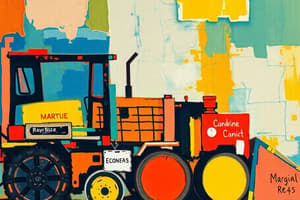Podcast
Questions and Answers
What is Babel's production function?
What is Babel's production function?
(0, 0), (1, 4), (2, 7), (3, 9), (4, 10)
What is Babel's marginal product of labor?
What is Babel's marginal product of labor?
(1, 4), (2, 3), (3, 2), (4, 1)
What is Earl's production function?
What is Earl's production function?
(0, 0), (1, 6), (2, 15), (3, 24), (4, 27), (5, 30), (6, 30)
What is the total cost function for Earl?
What is the total cost function for Earl?
What is Ralph's fixed cost?
What is Ralph's fixed cost?
How many workers does Ralph hire at a quantity of 3000 chickens?
How many workers does Ralph hire at a quantity of 3000 chickens?
Why does total cost increase faster as output increases?
Why does total cost increase faster as output increases?
Everything Looks Like a Nail's postage and packaging costs are __________.
Everything Looks Like a Nail's postage and packaging costs are __________.
The lease on the building for Everything Looks Like a Nail is __________.
The lease on the building for Everything Looks Like a Nail is __________.
A firm's __________ are costs that increase as quantity produced increases.
A firm's __________ are costs that increase as quantity produced increases.
A firm's __________ are incurred even if there is no output.
A firm's __________ are incurred even if there is no output.
What is the definition of marginal cost?
What is the definition of marginal cost?
What does the average total cost curve illustrate?
What does the average total cost curve illustrate?
All costs are either fixed or variable.
All costs are either fixed or variable.
Average fixed cost is always higher than average variable cost.
Average fixed cost is always higher than average variable cost.
Match the statements with their respective cost types.
Match the statements with their respective cost types.
Economies of scale begin at ______ and end at ______.
Economies of scale begin at ______ and end at ______.
Diseconomies of scale begin at ______ and end at ______.
Diseconomies of scale begin at ______ and end at ______.
Study Notes
Babel's Production Function
- Babel's production function indicates the relationship between the quantity of labor (workers) and the output of bricks laid.
- Key data points:
- 0 workers produce 0 bricks
- 1 worker produces 4 bricks
- 2 workers produce 7 bricks
- 3 workers produce 9 bricks
- 4 workers produce 10 bricks
- Marginal product of labor decreases as more workers are hired:
- From 1 to 2 workers: 4 additional bricks
- From 2 to 3 workers: 3 additional bricks
- From 3 to 4 workers: 1 additional brick
Earl's Food Trailer Business
- Earl's production function details the output of cupcakes based on the number of workers hired.
- Key data points:
- 0 workers produce 0 cupcakes
- 1 worker produces 6 dozens
- 2 workers produce 15 dozens
- 3 workers produce 24 dozens
- 4 workers produce 27 dozens
- 5 workers produce 30 dozens (maximum)
- Total cost is influenced by two factors:
- Fixed cost of parking ($40 daily)
- Variable cost of labor ($80 per worker per day)
Ralph's Chicken Processing Plant
- Ralph's total cost function correlates to the output of chickens processed.
- Fixed cost is determined to be $800.
- At a production quantity of 3000 chickens, 6 workers are employed, calculated as:
- Total Cost = Fixed Cost + Variable Cost
- $1400 = $800 + $100 × number of workers
- Total cost increases more rapidly as output rises due to diminishing returns to labor.
Costs of Manufacturing at Everything Looks Like a Nail, Inc.
- Fixed Costs:
- Lease on the building
- Industrial equipment costs
- Interest on current debt
- Liability insurance costs
- Annual salaries of top management
- Variable Costs:
- Postage and packaging costs
- Cost of wood used in manufacturing
- Cost of metal used in manufacturing
Understanding Costs
- Variable costs rise with increased production, illustrating diminishing marginal returns.
- Fixed costs remain constant regardless of output, not changing with production levels.
Cost Classifications
- Marginal cost defined as the change in total cost per change in output (ΔTC/ΔQ).
- Average variable cost calculated as total variable cost divided by quantity (VC/Q).
- Average total cost is derived from total cost divided by quantity produced (TC/Q).
Short-Run Cost Curves
- Assessing cost curves:
- Graph A is invalid
- Graph B is valid
- Graph C is invalid
- Graph D is invalid
- Graph E is invalid
- Graph F is valid
True/False Cost Statements
- Costs can be classified as fixed or variable.
- Average fixed cost decreases over time, whereas average variable cost can fluctuate.
- Average total cost (ATC) always exceeds average variable cost (AVC) in the short run.
Cost Interactions in Firm Dynamics
- Long-run average total cost (LRATC) curve showcases economies of scale, constant returns to scale, and diseconomies of scale at different production levels.
- Economies of scale occur up to a certain output level, followed by a phase of constant returns and eventually diseconomies.
Long Run vs. Short Run
- The long run allows for all inputs to be adjusted, contrasting the short run's fixed input limitations.
- Key insights on cost dynamics guide firms in optimizing production strategies and resource allocations.
Studying That Suits You
Use AI to generate personalized quizzes and flashcards to suit your learning preferences.
Description
Explore the concepts of production functions and marginal product of labor through Babel's architectural project. Use the given data to graph the production function and analyze labor's impact on output. This quiz will deepen your understanding of inputs and costs in economics.




